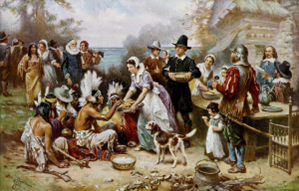Brief History of Thanksgiving
- The Mary Word
- Nov 12
- 3 min read
By Ainsley Benbow

Commonly associated with turkeys and apple pies, Thanksgiving is an annual holiday in the United States and Canada which dates back to the pilgrims era.
It all started in 1960, when a group of English settlers, the Pilgrims, arrived in North America aboard the Mayflower, seeking religious freedom and a new life in the ‘New World’. The first winter they spent in Plymouth (present-day Massachusetts) was utterly devastating, with nearly half of the 102 passengers dying from the cold, hunger, or disease. These conditions, while still adjusting to the new environment and way of life, made settling extremely hard; however, when spring came, the alliance with the local Wampanoag people helped their survival. For an estimated 12,000 years in the North American continent, the Wampanoag people had developed a distinct culture, language and relationship with the land. Through their enriched knowledge and understanding, they taught the pilgrims essential farming and survival skills which, if not for, the remaining settlers would not likely have survived another year.

In the autumn of the following year, after their first successful harvest, the Pilgrims and around 90 Wampanoag people, led by Governor William Bradford and Chief Massasoit, gathered together for a three-day feast to celebrate the harvest and their newfound, unlikely friendship. This event, marked by the sharing of food, peace and cooperation, later came to be remembered as the very first Thanksgiving. With events likely including ball games, singing, dancing, the infamous meal featured wildfowl (goose or duck), seafood such as lobster and clams, corn, beans, pumpkins and nuts, reflecting the land’s natural abundance, rather than the traditional dishes we know today, the Thanksgiving tradition and spirit were born.
Over the following centuries, colonists continued holding days of thanksgiving for blessings like good harvests or victories, but it wasn’t until 1863, during the Civil War, that President Abraham Lincoln declared Thanksgiving a national holiday. This was to encourage unity and gratitude, embracing those close to us in a shared meal for thanksgiving and to deepen the relationships within communities. Later on December 26, 1941, Congress officially passed a joint resolution, signed by President Theodore Roosevelt, that declared the last Thursday in November to be the legal Thanksgiving Day.

Today, Thanksgiving is a time for family and friends to gather and share a large meal, expressing their gratitude for the blessings and all they have in their lives. Many people also watch parades, football games or even, in the spirit of giving, volunteer to help those in need so thanks can be felt by all. Contemporary staples include turkey, mashed potatoes, cornbread, apple pie, sweet potatoes, and cranberry sauce that have been introduced later as new traditions, especially as regional foods have developed over time. On the contrary, this day acts as a reminder of the hardships and devastations faced following colonisation for many Indigenous Americans.
Overall, Thanksgiving remains a moment to pause, reflect, and give thanks for all the people and blessings that sustain us, acting as a reminder of how compassion can bring people together even in the most challenging times. The holiday reenacts, in spirit, the 1621 feast shared by the Pilgrims and Wampanoag people, where a simple gathering between two diverse cultures created not only a foundation for a national holiday, but a lasting symbol of gratitude, peace, and the appreciation for all that we have.
References:
https://www.archives.gov/legislative/features/thanksgiving https://www.britannica.com/topic/Wampanoag



Comments